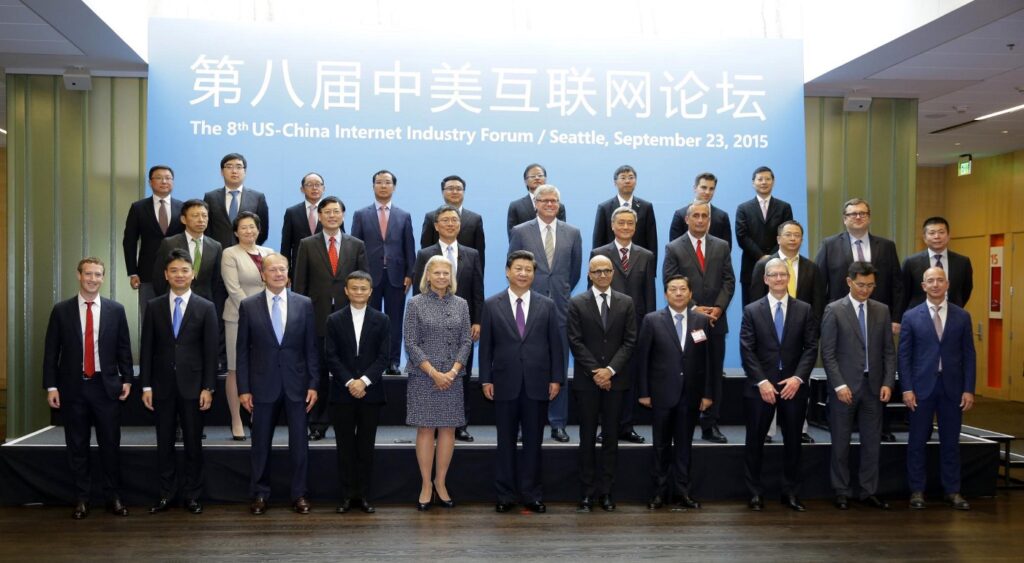Is heavy-handed state intervention killing entrepreneurship in China? William Kirby, Spangler Family Professor of Business Administration at Harvard Business School, T. M. Chang Professor of China Studies at Harvard University, and Chairman of the Harvard China Fund explains.
This article first appeared in the Harvard Business Review on August 2, 2016.

Last September some of the world’s foremost technology industry leaders met in Seattle with Xi Jinping, president of China. In a group photograph, 30 CEOs with a combined market capitalization of $2.5 trillion smiled for the camera alongside the Chinese leader. They included Microsoft CEO Satya Nadella, Facebook CEO Mark Zuckerberg, and leaders of some of the most prominent “sharing economy” companies: Airbnb CEO Brian Chesky and Didi Chuxing CEO Cheng Wei, the head of China’s leading taxi and private car hailing app. Conspicuously absent from the photo was Uber’s CEO, Travis Kalanick.
This did not bode well for Uber’s future in China. On Monday Uber said that it is selling its operation in China to a rival Chinese ride-sharing company whose CEO was in that foreshadowing photo. Cheng Wei will get a seat on Uber’s board as part of the deal. Kalanick gets the same on Didi Chuxing’s board, and Uber gets around a 20% share of the Chinese company, which will run Uber’s Chinese operation as a separate brand.

Much of the U.S. news coverage has centered on Uber capitulating to competition and getting schooled by its Chinese archfoe. It is true that Kalanick consistently called China the most important market for Uber. He joked to a Chinese publication that he was spending so much time in China that he should apply for Chinese citizenship. Uber truly wanted to succeed in its fastest-growing market, one where taxi drivers outnumber their U.S. counterparts tenfold. The company’s losses were mounting in a bid to win market share.
Still, I believe Uber is leaving China not because of interference from its rivals but because of interference from the state.
When Uber entered the Chinese market, it soon learned it had to change its core product. At first, customers had to validate credit card information before opening an account. This presented a major obstacle for many potential Chinese users. Uber China recognized this disadvantage in its business approach and, just in time for the formal launch in February 2014, added the option of payment through Alipay.
After that, Uber continued to use Google Maps to locate and match customers with drivers. But Google Maps coverage in China was extremely limited and notoriously inaccurate. So Uber China entered into a strategic partnership with Baidu in December 2014. Baidu, an economically powerful and politically connected company, was now in Uber’s inner circle of investors. Uber China also installed servers on Chinese soil to prevent its operations from getting disrupted while passing over China’s notorious firewall.
Yet even after making its core product more attractive to Chinese customers, Uber had to spend hugely to attract drivers and riders. New users were attracted to the platform by large discounts on their first trip, often equivalent to the full cost of the ride. Similarly, drivers were encouraged to join the service. In Chengdu, Uber drivers numbered 42,000, nearly the same as the number of Uber drivers in London, Paris, and San Francisco combined. But the company’s capital investment had an unintended consequence: It gave rise to a rampant economy of drivers faking trips for personal profit.
It was costly, but it still worked. Despite intense competition from two Chinese taxi-hailing services (that later merged to take on Uber more directly), Uber was succeeding because it could drive in a gray zone of Chinese markets.
After all, Uber’s aggressive push into China was made possible by the fact that the space was largely unregulated. The company founded local entity after local entity in China to compete in different urban markets. That’s a proven strategy; China is not one market for almost anything. My colleague Meg Rithmire has shown that different cities in China can have very different regulatory environments. Many successful private companies in China have realized they can succeed in areas where the government is not yet present or where it has not yet set regulations. Basically, you can succeed in any form of business that is not yet illegal. Ride sharing was one such business.
The losses Uber was taking to win market share were unsustainable. But the same goes for its erstwhile chief rival. Didi Chuxing had become the dominant Chinese player in the space. But neither company could afford the high level of subsidies (and resulting costs from driver corruption) needed to win new drivers and riders and new markets.
The losses Uber was taking to win market share were unsustainable.
In the end, it wasn’t competition that spelled Uber’s demise in China; it was impending national regulations. Uber was negotiating with Didi Chuxing as a new regulatory scheme was being written. The nationalization of industry regulation was bad news for a startup that depended on local variance and gray zones.
These national regulations are now a reality. To be sure, the headline reads well in the Xinhua news release on July 28, 2016: “China Grants Legal Status to Ride-Hailing Services.” But legal status in China can come with handcuffs. The country’s first nationwide regulation of the industry was truly bad news for Uber and, if followed to the letter, bad news for the entire industry.
The country’s first nationwide regulation of the industry was truly bad news for Uber and, if followed to the letter, bad news for the entire industry.
Under the new regulations, the data collected by Uber would come under the purview of the government. There would be no more subsidies. Market prices would prevail, the regulations state, “except when municipal government officials believe it is necessary to implement government-guided pricing.” According to Xinhua, ride-hailing companies would be urged to merge with taxi companies. (Many of those also happen to be owned by the local governments.) Uber would have to get both provincial and national regulatory approval for its activities anywhere in China. Online and offline services would be regulated separately.
Moreover, foreign companies like Uber would be subject to even more regulation than their competitors. Even though Uber had been registered in the form of local companies, its national platform would now be handled differently. And despite this standardization of the industry, local governments would be allowed to issue “ride-hailing service driver’s licenses” and to determine who is eligible to be a driver and what kinds of cars can be driven.
This national regulation was an impending disaster for Uber. In retrospect, perhaps the company could have remained in charge and made money had it kept to its initial “niche” market for wealthy Chinese people and expats. But by going for the mass market to reach higher valuation and to fuel its larger platform strategy, Uber brought on extra challenges. Central government regulations were almost inevitable.
There is an English saying that a picture is worth a thousand words. You could certainly apply that to the fateful photograph of Xi Jinping and the top technology CEOs — the one where Kalanick is out of the picture.
There’s also a saying in China: “The nail that sticks up is the nail that gets hammered down.”
Here is the takeaway. Where the Chinese state steps in is where entrepreneurship goes to die. In selling its China business to Didi Chuxing, Uber is getting out of its China operations at the right time and at a reasonable price.
William C. Kirby is the Spangler Family Professor of Business Administration at Harvard Business School and the T. M. Chang Professor of China Studies at Harvard University. His latest book, co-authored with Regina Abrami and F. Warren McFarlan, is Can China Lead? (HBR Press, 2014). He is the co-author, with Joycelyn Eby, Adam Mitchell, and Shuang Lu, of the case study, “Uber in China: Driving in the Gray Zone” (2016).

